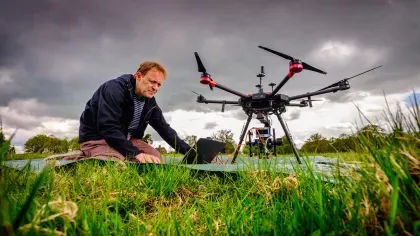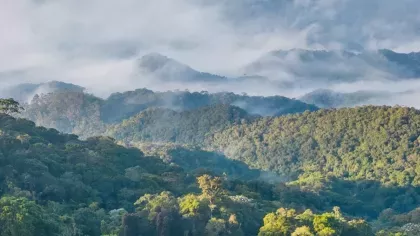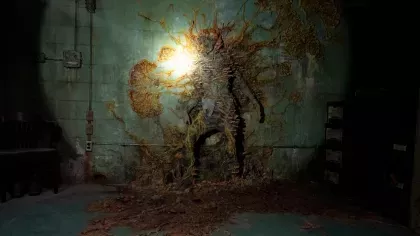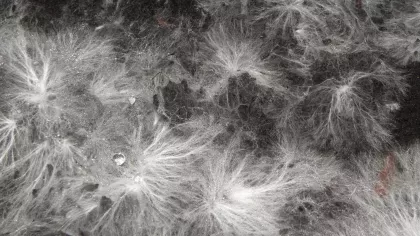21 October 2022
How fungi will save the world
There's thousands of diverse species, living in every habitat on the planet, and we've only just scratched the surface. But fungi might be the secret weapon in helping fight disease, plastic pollution and climate change.

Whenever you’re out exploring nature, you’ll be sure to spot a fungus. But it’s become more common to see fungi playing a role in our day to day lives too.
Fungi are rapidly becoming key players in helping humanity combat pollution and climate change, as well as a myriad of other problems.
While you might already be familiar with fungi as meat replacements on your dinner plates, here we take a look at some of the other ways fungi could help save the world.

Transplants and fungi
Fungi have been helping save the world for years. A number of medicines commonly used today are fungus-based.
The antibiotic penicillin was famously discovered by Alexander Fleming when he found that a blue-green mould prevented the growth of infectious bacteria in one of his experiments.
Lovastatin, a cholesterol-lowering drug used to help combat heart disease, was first isolated from a soil-based fungus called Aspergillus terreus.
One of the lesser-known fungal-based medicines is an immunosuppressant called ciclosporin. It’s used to help increase the success of organ transplantation. This versatile drug was discovered in the fungus Tolypocladium inflatum, a mould that is commonly found in soil and leaf litter.


Part of the life cycle of this fungus sees it parasitise scarab beetle larvae that also develop in the soil.
To ensure that it can successfully infect its unwitting beetle host, the fungus produces a range of chemicals aiming to ‘switch off’ the immune defence of the insect. One of these is ciclosporin, which reduces the body’s ability to make inflammatory cytokines, proteins that play a key part in our immune response. This works just the same in humans as it does in insects.
While we usually want to keep away from chemicals like this, there are times when suppressing the immune system come in useful, such as organ transplant.
When a donor’s organ like a liver or a kidney is transplanted, the new body’s immune system identifies it as a foreign object and will attack it, causing it to be rejected. Ciclosporin reduces the body’s immune response, giving the new organ an opportunity to be accepted.
This compound found in a tiny soil fungus parasitising insects took organ transplantation from a risky experimental therapy to a daily, life-saving procedure.
A game-changing discovery, all from a common mould.

Fungi vs plastic
One of the key roles that fungi play in our ecosystem is breaking down organic matter, keeping it moving through the carbon cycle. Over millions of years’ worth of evolution, they’ve gotten pretty good at breaking down very complex natural polymers, like cellulose, one of the main structural components of plants.
While cellulose is a natural polymer, plastics are produced by humans. The difference lies in how long they’ve been around. Cellulose has been part of our ecosystem for millions of years, while plastic is the new kid on the block, invented just over 100 years ago.
As a result, the natural world hasn’t had time to catch up. Very few organisms can break down plastics, and almost none of them can feed on it. But scientists are confident that they can ‘help’ fungi and bacteria to learn how to make use of plastic and, in turn, reduce plastic waste.
There are millions of fungi species, found in every ecosystem, with a wide range of characteristics. So how do we find ones which have plastic degrading potential?
One good place to start is go where the plastic is. Researchers look at plastic debris in landfills or floating plastic ‘islands’ in the ocean, in the hopes that these habitats will be full of species capable of plastic degradation.

In 2017, scientists in China and Pakistan identified a strain of Aspergillus tubingensis that was breaking down plastic in a landfill site in Islamabad.
This fungus is common in tropical soil and can cause crop spoilage. But scientists discovered that samples of this fungus were hard at work breaking down polyurethane plastics in a matter of weeks, a process that would normally take years.
Dr Irina Druzhinina at the Department of Accelerated Taxonomy, Kew Gardens and her colleagues in Shenzhen and Nanjing (China), Berkeley Laboratories in California (USA), and the University of Portsmouth have been working with fungi from the genus Trichoderma.
They discovered that some Trichoderma species can efficiently degrade polycaprolactone, a plastic more easily broken down by micro-organisms.
The next step is to use the enzymes they produce as a starting point for engineering more effective compounds. Hopefully, these can used to speed up the breakdown of more resistant plastics like polyethylene terephthalate, or PET, which is used in food packaging and drink bottles.


The spore, the better
It’s clear that fungi have an important role to play in the future of our world, helping us tackle challenges like climate change, biodiversity loss and food security.
We’ve looked at just a few of the ways that fungi are helping, but we’ve only just scratched the surface.
Beyond the hidden uses of fungi in everyday life, there's exciting new developments leveraging the power of these incredible species.
Fungi are being used as biopesticides, reducing the impact of insects on food crops in an eco-friendly way, while other fungi are used as biofertilisers, enriching the soil to improve crop yields.
Fungal mycelia, the root-like growths of fungi, are being used as a green replacement for polystyrene packaging. The mycelium is grown into suitable shapes, then mixed with agricultural waste to create a protective foam.
Fungi even show promise in bioremediation, the process of using living organisms to clean up polluted sites. They have been found to be able to process heavy metals and even radioactive material, so could be used to clean-up hazardous materials in the environment.

Every year, we uncover more about the diversity of fungi, their genetic makeup and their biochemistry.
As we learn more about how they work and what they can do, we’ll no doubt discover even more ways in which fungi can help save the world.





